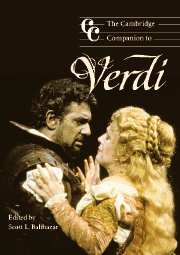Book contents
- Frontmatter
- Part I Personal, cultural, and political context
- Part II The style of Verdi's operas and non-operatic works
- Part III Representative operas
- 11 Ernani: the tenor in crisis
- 12 “Ch'hai di nuovo, buffon?” or What's new with Rigoletto
- 13 Verdi's Don Carlos: an overview of the operas
- 14 Desdemona's alienation and Otello's fall
- Part IV Creation and critical reception
- Notes
- List of Verdi's works
- Select bibliography and works cited
- Index
14 - Desdemona's alienation and Otello's fall
from Part III - Representative operas
Published online by Cambridge University Press: 28 September 2011
- Frontmatter
- Part I Personal, cultural, and political context
- Part II The style of Verdi's operas and non-operatic works
- Part III Representative operas
- 11 Ernani: the tenor in crisis
- 12 “Ch'hai di nuovo, buffon?” or What's new with Rigoletto
- 13 Verdi's Don Carlos: an overview of the operas
- 14 Desdemona's alienation and Otello's fall
- Part IV Creation and critical reception
- Notes
- List of Verdi's works
- Select bibliography and works cited
- Index
Summary
In an oft-quoted assessment of Shakespeare's Desdemona, Verdi described her as “not a woman, but a type. She is the type of goodness, resignation, self-sacrifice. They are creatures born for others, unconscious of their own egos.” Shakespeare's play, of course, provides ample material for this sort of interpretation, as characters extol her beauty, virtue, selflessness, and other merits. And as James Hepokoski has documented, in recreating Desdemona for their own Otello (1887) Verdi and his librettist Arrigo Boito were probably influenced by nineteenth-century critical traditions represented by August Wilhelm Schlegel and by Victor Hugo, who viewed Desdemona as “saintly” and as “a spiritualist and almost amystic,” and also seem to have drawn upon such late nineteenth-century literary themes as decadentismo devotional iconology and the femme fragile. Of course devout heroines in peril were nothing new to Verdi, the Leonoras in Il trovatore and La forza del destino being prime examples, while heroines falsely accused had long been stock-in-trade, and Violetta (La traviata) provided a precedent for the physically fragile heroine. So by emphasizing Desdemona's purity, naïveté, and vulnerability, Verdi and Boito adhered to an aesthetic involving the cathartic destruction of a sympathetic female lead with which their audience could readily identify.
- Type
- Chapter
- Information
- The Cambridge Companion to Verdi , pp. 237 - 254Publisher: Cambridge University PressPrint publication year: 2004
- 1
- Cited by

